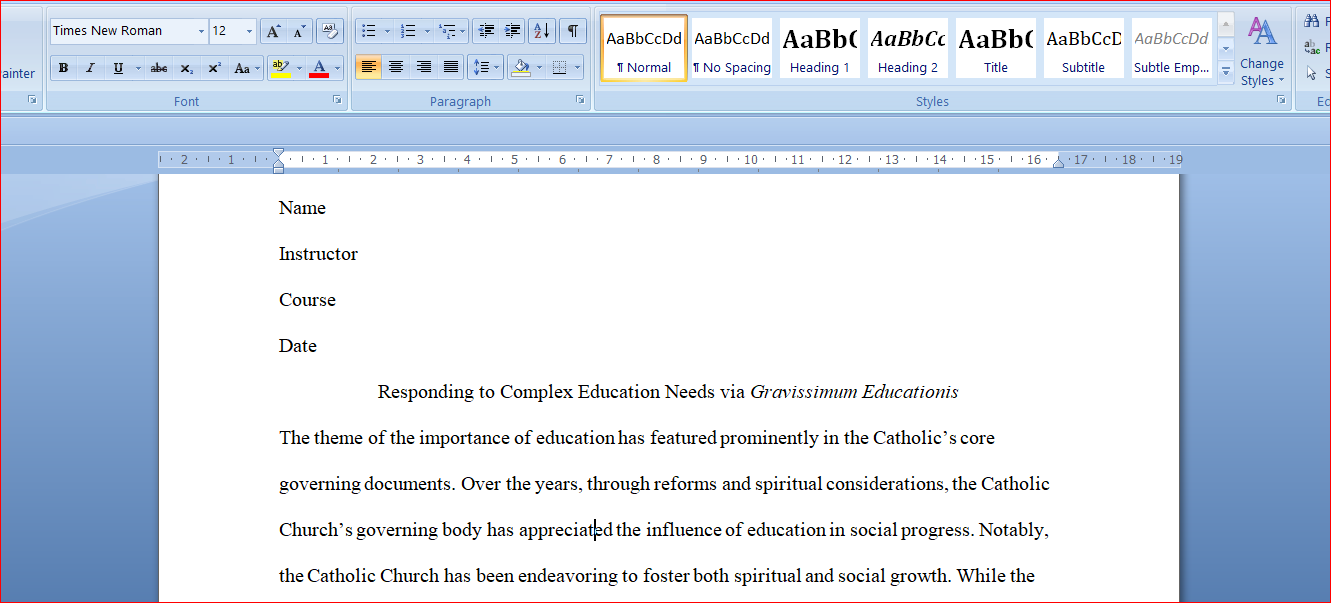Responding to Complex Education Needs via Gravissimum Educationis
Conciliar Traditions
Vatican II – Final Paper Prompt
As portrayed in class lecture over the past several weeks, Vatican II’s four core constitutions (Dei Verbum, Lumen Gentium, Sacrosanctum Concilium, and Gaudium et Spes) together offer a coherent vision, a unified framework, and core themes and principles for all that the Council wished to say to the Catholic Church, to all Christians, and to the whole world. At the same time, the remaining 12 documents (or at least 9 of them), addressed more specific issues confronting the Catholic Church in the modern world. They did so in, though, within the larger vision and framework of the 4 core constitutions, and often bringing those core principles and themes to bear on the specific topic addressed (e.g., religious freedom, ecumenism, etc.).
The basic task of this final assignment is to write a paper (between 10-15 pages in length) focused primarily, indeed almost exclusively, on just one of these 12 documents (i.e., not one of the 4 core documents). The general assignment is to interpret your chosen document in light of, or from the perspective of, the vision, framework, and principles of the 4 core documents.
The form of your paper must be that of a thesis-driven argument about the document. That is, you must make a specific interpretive claim about the document at the outset (i.e., in the Introductory section) and then use the remainder of the paper to prove your specific claim. Put negatively (i.e., what you must not do), you’re not to summarize the contents of the document; nor are you simply to exposit or explain it in the form of a running commentary (i.e., first it says this, then it says that, then its says something else)…
The method of your paper is to prove your thesis by interpreting the text, making extensive use of quotations, citations, and text-based observations (e.g., “theme X appears clearly in paragraphs 3, 6, and 12, thus suggesting its prevalence at key points in the document”).
The best analogy for all this is that of a courtroom drama: the text is the defendant; I am the jury; you are the prosecutor, and you’re bringing a case against the text, trying to prove or demonstrate the truth of your interpretation. Your case is the paper’s thesis. In short, your task is to convince me that the text has the particular meaning that you claim that it has in your thesis
The goal of your interpretive argument is to enhance, or deepen, or enrich the understanding of the document you’ve chosen for a hypothetical reader of the document (e.g., an interested friend, roommate, family member, etc.). That is, armed with the interpretative insight of your paper, a hypothetical reader of the document would understand better the document itself and how it fits into the larger event of Vatican II.
A silly, but hopefully illustrative example:
A central theme running through the four core documents is the color purple. Frequently, purple appears as a crucial feature of the fully-formed and well-functioning “gwart” and every discussion of “gwartness” in the four documents includes the mention of purple. Strikingly, when the Council turns to address the specific topic of high-powered fashion ensembles in the document “Sartorial Gwarts for the 20th Century,” the theme of purple occurs at key points in that document too, though in subtle and not always easily noticed ways. Attending carefully to the theme of purple thus reveals not only a central concern of the document “Sartorial Gwarts” itself, but also enables the reader to see how the concerns of that document fit into the larger objectives of the entire Council itself.
“Sartorial Gwarts” has three mains sections, each of which deals with some aspect of the Gwart as it pertains fashion and clothing. As will be demonstrated in this paper, the color purple shows up at key points in each of the three sections, revealing its centrality to the document as a whole. In order to appreciate fully the importance of purple in this document, though, it presence in the very last section, the third section, must be treated first. For only after fully grasping how purple functions in the third Section is it possible to see its more subtle presence and significance in Sections I and II.
Answer preview for responding to Complex Education Needs via Gravissimum Educationis
Words:3214

